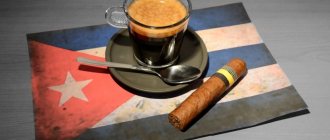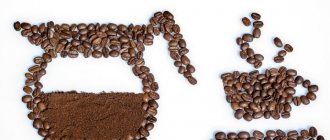The popularity of coffee in Europe began relatively recently, but the tradition of consuming this wonderful drink has ancient roots. Coffee traditions have been formed over centuries, acquiring new, sometimes very bizarre forms along with the spread of coffee around the world, reflecting the characteristics of the cultures of those peoples who discovered coffee beans. In some countries, the culture of drinking the drink is so firmly woven into everyday life that it is simply impossible to imagine them without it - these countries may well lay claim to the title of “coffee countries”. How exactly do coffee drinkers support the greatest coffee lovers in Italy, Turkey and Ethiopia?
Brazil
If you are a true coffee connoisseur, then you know for sure: Brazil is a coffee country. Almost a third of all grain grown in the world belongs to this state. But not only in terms of yield and volumes of coffee exports, Brazilians are ahead of other countries. Temperamental South Americans also occupy a leading position in the consumption of this wonderful drink. They drink it for breakfast, after lunch and dinner, as well as instead of and in between. Tea is chosen only on special occasions. The most popular coffee drink in Brazil is called cafezinho, which translates to “little coffee.” It’s not enough because they only pour half a glass of it, although you can add a little more water or milk if you wish. But it will be a different drink. Sometimes “cafezinho” is served in small cups. Brazil's national coffee is filtered using a cloth or paper strainer and served hot and very sweet.
Coffee traditions and coffee ritual in Ethiopia, the birthplace of coffee
Coffee holds a sacred place in this country—more than 12 million Ethiopians are involved in the growing and harvesting process alone, and it generates more than two-thirds of the country's income.
The best Ethiopian coffee can be compared to the best coffee in the world, and the premium washed beans command some of the highest prices in the world market.
In a world where time has long been a commodity, the Ethiopian coffee ceremony takes us back to a time when communication and human relationships were valued.
Perhaps the ancient proverb best describes the place of coffee in Ethiopian life, “Buna dabo naw,” which translates to “Coffee is our bread!”
For hundreds of years, coffee has become an integral part of the cultural and spiritual life of the Ethiopian people, the country of origin of coffee.
Harar was an important cultural and commercial center in Ethiopia from the late 16th century to the 19th century. For centuries, coffee has symbolized the prosperity and wealth of this land.
Residents of Harar believe that coffee increases intelligence and leads to prosperity. They enjoy coffee in the morning, offer a glass of coffee and pray: “Protect us from evil, give us rain and herbs.”
jebena
The scale of the coffee shop is a sign of the power of the aristocratic families who work for the royal family. The coffee producer's name is Kharash. They are absolutely protected in the city to preserve the art of coffee planting.
Especially in Ethiopian culture, coffee holds a very sacred position.
According to legend of the Oromo people, an ethnic group that once dominated the Ethiopian Empire in the 18th and 19th centuries, the first coffee tree grew from the tears of God. Therefore, they perform coffee rituals with the belief that God will bless the new life with many new creative ideas.
roasting coffee over charcoal in Ethiopia
As part of the coffee ritual, Ethiopians drink coffee with neutral water so that the energy of the coffee is fully released, helping the thinking processes. After enjoying the coffee, they discuss and put forward bold initiatives to solve specific problems related to life situations, marriage or some adventure event, travel.
To this day, over hundreds of years, coffee continues to play an important role in the cultural, social and economic life of Ethiopia.
It is estimated that there are currently over 6,000 types of naturally grown coffee in the highlands of Ethiopia. It is believed that Arabica beans, grown in the homeland of coffee, have the most unique taste in the world.
traditional coffee roasting in the birthplace of coffee
Ethiopian coffee beans, thanks to the energy of the sacred land, contribute to the creation of a unique, special energy coffee that unites coffee lovers around the world. A powerful creative source.
Enjoying coffee is an essential ritual in the social and cultural life of the Ethiopian people. Attending a coffee ceremony is a sign of friendship, respect and hospitality.
The original name of Ethiopia is Abyssinia. It is the oldest independent country located in northeastern Africa, where Arabica coffee trees are grown in desert valleys of red soil, volcanoes and fog at an altitude of thousands of meters.
Ethiopians take coffee rituals very seriously. Rituals are not only a form of culture, but also an event that binds friendship and mutual respect between people. In most parts of Ethiopia, coffee rituals are performed three times a day - in the morning, at lunch and at dinner. This is a major social event in the village and a time to discuss current issues in the community.
Ethiopian woman pours coffee
A coffee ceremony can also be held at any time at home to greet friends.
The woman plays a key role in the ritual. They wear white traditional costumes and perform rituals from roasting to grinding coffee. First, the ritual site is covered with fresh herbs and flowers. The hostess of the ceremony burns incense to purify the atmosphere and ward off evil.
Pure water is measured into a jug or black ceramic, round vessel (called Jebena) and then placed on coals. Fresh coffee beans are washed and roasted in a cast iron skillet with a long wooden handle. The coffee is slowly roasted over real heat and stirred constantly to release the aromatic oils without burning them black. The aroma of coffee when roasting also contributes to the atmosphere of the ceremony.
coffee aroma
When the roasted and ground coffee is ready, the water is heated. The woman in charge of the aromatic coffee in the kettle heats it until the coffee is properly extracted and begins to pour it out to the guests. A tray with ceramic or glass cups (Cini) is poured simultaneously for all those present. The coffee grounds remain in the teapot rather than being poured into the cup.
The youngest invite the elders to enjoy their first cup of coffee. The host of the festival welcomes everyone present (Banna Tetu). Guests can add sugar to the drink if desired. A polite guest will praise the host for the choice of ingredients and who brewed the drink.
After the first cup, the ritual is repeated with the second and third cup. The three rounds of coffee are called successively abol, tona and baraka. The first two cups of coffee, abol and tona, symbolize the transformation of the spirit. The third cup - baraka - means blessing.
When roasting coffee, the owner can add cardamom, cinnamon and cloves to enrich the taste of the drink with spices. These are the rich aromas of the tropical earth, thanks to the light and warmth of the sun - in combination with all four elements of earth, water, fire and wind, helping people to be in harmony with each other and with the earth. Thanks are given to heaven in order to enjoy earthly happiness.
coffee ceremony
Türkiye
In this eastern country, residents value coffee not only for its unique taste, but also for the opportunity to discover the future with its help. Any tourist can also take advantage of this national tradition. Everything is very simple. At any local establishment or coffee shop, you order freshly brewed Türk Kahvesi coffee, which is prepared in a Turk placed in hot sand, enjoy it while eating sweet Turkish delight and go with the remaining coffee grounds to the fortune teller. Based on the contours of the remains of the invigorating drink, she will tell you what she sees. What exactly the fortune teller will discern and from which hidden chest of fantasies he will voice the local version of the “Rorschach test” is not so important. This is part of a long-standing and colorful ritual. And if you don’t like the prediction, don’t worry. There is a saying in Turkey: Fala inanma falsız kalma (“Don’t believe in fortune telling, but guess”). Yes, and to find a fortune teller, you don’t have to dig through local newspapers with advertisements; many cafes provide this service completely free of charge.
There is another local coffee drink that is definitely worth trying. It's called "The Secret of the Old Moor." You could say this is coffee with a twist, the role of which is played by ordinary garlic in the literal sense of the word. But it is very difficult to guess that this ingredient is there. Garlic mixed with grains, and even seasoned with honey, simply enhances the taste of coffee and makes it unforgettable.
Facts from coffee history
- Humanity did not immediately figure out how to brew a coffee drink - first they chewed the beans, then prepared them in the manner of tea. It was customary for ancient travelers to mix crushed grains with fat and prepare something like flat cakes, which provided good energy during long hikes.
- In the Arab world, the drink was traditionally prepared in long jugs called “dalla”. This tradition has been preserved - even in the 21st century, in some Arab establishments coffee is served in exactly this type of container.
- It is interesting to learn about how the cezve (aka “Turk”) appeared. One of the sultans was very fond of coffee, but an ordinary dalla was not suitable for the royal court, and the drink regularly “ran away” from golden dishes. One of the viziers undertook to solve this problem. Through trial and error, he managed to find the ideal shape of the cezve and learned that copper or silver should be used as the material for production.
- Coffee first appeared among the Arabs, but attitudes towards it changed over the centuries - it was either completely prohibited or forcibly imposed. Eventually it became a popular drink, consumed by both sultans and peasants. At one time, to popularize coffee, merchants promised heaven to everyone who drank it. Alcohol is prohibited by the Koran, and coffee invigorates quite well, without falling under religious sanctions.
- Coffee has become so firmly established in the lives of Arab peoples that it has become an official reason for divorce. In Turkey, a wife could legally divorce her husband if he was unable to provide her with enough drink.
- Coffee gained a foothold in European territory in the second half of the 16th century thanks to Pope Clement VIII. He liked the taste and aroma of the drink so much that he allowed its widespread consumption. Previously, coffee was considered sinful because it was drunk by Muslims.
- The first public establishment in Europe where coffee was brewed opened in Oxford (England) in 1637, and on the mainland - in Venice in 1654.
- European coffee houses quickly became meeting places for students, teachers, philosophers, writers and poets.
- Many monarchs banned such establishments as breeding grounds for freethinking. For example, Charles XII in 1675 issued a decree to close all coffee shops in the country, and Frederick the Great in 1777 banned not only the establishments, but also the drink itself, organizing a special supervisory body or “coffee investigation.”
- Americans became massively addicted to coffee in 1670. Previously, they preferred to drink beer at breakfast.
Finland
If you like to add dairy products such as milk or cream to your coffee, you will most likely enjoy Kaffeost Finnish coffee. For an unusual taste, “milk” is also added to this strong, aromatic drink, only in the form of Lapland cheese Leipäjuusto (“Bread Cheese”). This cheese is made from cow's milk, sometimes with the addition of goat and deer milk, then baked in the oven until golden brown, cut and placed in a coffee cup. They say that local residents are absolutely delighted with it. By the way, this drink is also popular in neighboring Sweden.
In Italian
Italians love to drink espresso with lemon - this way the aroma of their favorite drink is more intense.
The wreck of a 200-year-old 18th-century British ship is being examined by Mexican scientists.
Tired of attention: “lost” Svetlana Svetlichnaya was “found” at home
Relationships of Maria Gorban before she found a loved one and a happy family
Malaysia
Malaysia is famous for its “white coffee” (Ipoh coffee). This amazingly tasty and invigorating coffee drink is not made from white beans, as many people think. This type of coffee simply does not exist in nature, do not believe the legends and (especially) advertising. To get “white coffee”, Arabica, Robusta and Liberica are mixed, then roasted together with palm margarine (lightly roasted), hence the light color of the beans. Well, on top of everything else, condensed milk or cream is added to coffee.
Senegalese coffee
Cloves and Guinea pepper are roasted and ground together with coffee beans, then brewed. The strong, spicy drink is filtered through a filter before serving.
Studies show vapers are 17% more likely to spread coronavirus
Chess, a push-button telephone and a military camp: how Vodonaeva is raising her son
3 children and 17 years of marriage: what Pashkov’s ex-wife is doing now
Hong Kong
"Coffee or tea?". Quite often we ask ourselves this question (or we are asked). But in Hong Kong this is never a problem. Those undecided are offered the Yuenyeung coffee drink, which is a combination of black coffee (30%) and Hong Kong “silk stocking milk tea” - a mixture of several black teas (70%), flavored with thick fat milk (you can use condensed milk if you like sweet tea). The resulting unusual caffeine cocktail can be consumed both hot and cold.
In Irish
The thick drink is a mixture of hot black coffee, sugar and Irish whiskey, topped with a lush cream foam.
Fashion trends 2021 for women over 45: best looks and tips
Arthritis, diabetes: how the oral cavity affects body diseases (research)
Cowboy boots for women are at the height of fashion in the spring: how and what to wear them with
Vietnam
But coffee with cheese, dear reader, is nothing. In Vietnam, gourmets went further and added eggs to the strong drink. “How can you drink this?” - you might think. Very simple, and with great pleasure. After all, in appearance and taste, Vietnamese coffee Cà Phê Trứng (coffee with egg) resembles a dessert. To prepare it, robusta beans are used, which are dark roasted and coarsely ground, and then passed through a special Vietnamese coffee filter. Beat egg yolks with condensed milk and sugar until foam forms, add all this beauty to coffee and cook the drink over low heat. This is a kind of eggnog from Vietnamese connoisseurs. Cà Phê Trứng can also be drunk hot or cold.
Portugal
The Portuguese can perhaps compete with the Brazilians in the amount of coffee consumed per day. In this country, they also love coffee and drink it in abundance - in liters, at any time and in any place. 5-6 cups a day, or even more. Espresso is especially held in high esteem by locals. To brighten up the drink, many Portuguese prefer to add lemon juice or lemon-flavored soda. Even if you just imagine it, it’s quite an “explosive” elixir. By the way, in Italy the classic coffee drink is espresso with a slice of lemon. There is something in this, you need to try it.
French coffee requires a cup large enough to dip the croissant
Today you can order a latte anywhere in the world. The main feature of this French café au lait is the cup or glass in which it is served. The cup or glass should be large enough to easily dip croissants or even baguettes, as this is a long-standing French tradition.
This is also interesting: The best and worst countries for women
Mexico
For lovers of spices (and there are many of them), Mexican coffee is a must - Cafe de Olla (coffee in a pot). This is a drink with its own history. During the Mexican Revolution, it was used by soldiers and their leader Emiliano Zapata as a natural energy drink. Today, they drink it not only for good spirits, but also just for pleasure, sipping from special clay cups. To prepare it, the most popular spices are used - cloves, cinnamon sticks, anise, mixed with ground coffee beans, water and cane sugar (piloncillo). Coffee is brewed over low heat in special clay pots, then filtered through a sieve. Mexicans, not without reason, believe that earthenware helps the taste of coffee beans to develop better.
Café Touba – Senegal
The authorship of the recipe is attributed to the Sufi sheikh and founder of the Islamic order Muridiya. The first mention of Tuba coffee dates back to the second half of the 19th century. To this day, the drink remains a symbol of brotherhood and is traditionally present at festive events and important ceremonies of the order. Initially, Café Touba was attributed exclusively to medicinal properties, but now it is drunk to invigorate. To prepare Tuba, a mixture of crushed coffee beans, cloves and black Guinea pepper is brewed. Only local residents can handle such a drink - as practice has shown, the stomachs of tourists are not so strong.
Arab countries
Saudi Arabia also loves spices. Why, in all Arab countries coffee is brewed with the addition of a whole kaleidoscope of spices. In addition to those added by Mexicans, Arabs also experiment with cardamom, cloves, saffron and ginger. And in Morocco, when preparing coffee, they also use black pepper and nutmeg. But according to local traditions, you need to choose spices for a drink based on a specific case. So, if a happy event happened in the house, Moroccans add sweet notes to the drink, but if it’s the other way around, they brew bitter coffee.
Ireland
Perhaps, coffee in this country is most often drunk in the evenings, after a hard day at work, or to warm up. The islanders can be understood; they can enjoy the taste and aroma in the morning or in the middle of a working day, but with unpredictable consequences: one of the ingredients in the coffee here is alcohol. As an additive to coffee, the Irish use whiskey with added sugar and whipped cream, mainly for decoration. Irish Coffee should be drunk without stirring so that you can gradually feel the combination of flavors and enjoy it.
France
Well, what Frenchman doesn’t like to start his morning with a cup of freshly brewed black coffee and a crispy croissant! The smell of an aromatic drink and baked goods simply knocks you off your feet. And if suddenly the ritual is broken, the day may not work out. This is why locals prefer to wake up a few minutes earlier, so that they can spend this time with a cup of coffee in hand, without rushing anywhere. In France, they drink coffee with the addition of fresh milk and always from a large cup - this makes it easier to dip baked goods into it.
Dishes for drinking natural coffee
In order to preserve the inimitable taste qualities that bean coffee has, you should carefully select the appropriate utensils. Coffee is a product with high absorption qualities, which means that the composition of the raw material, and only then its shape and design level, should be the key factor when selecting tableware.
Cups made of high quality natural clay and porcelain most emphasize the flavor tones of natural coffee. Earthenware sets, the most represented in the coffee set segment, do not create the necessary unique taste, but it is very rare now to find orthodox metal sets made of copper-containing alloys, and copper molecules are known to intensively enhance the flavor fluids of coffee.
The volume of a cup for natural coffee should be a maximum of 60 ml. The shape of a coffee cup in European traditions is cylindrical with a small diameter, and among southern peoples it is customary to drink coffee in a miniature bowl-shaped container.
Japan
There are no top-secret ingredients in Japanese latte, but local residents and guests of the country are ready to stand in line for this drink. And this is not without reason. After all, such an original presentation of a coffee drink can only be found in the Land of the Rising Sun. Coffee with 3D images is winning more and more hearts of the Japanese and is already seriously competing with green tea. Do you also want a cup of hot latte with a dancing cat? Off to Japan.
Back Next
Pharisaer – Germany
The coffee contains unusual ingredients: brewed beans are complemented with whipped cream and rum. The tradition originated in the country many centuries ago and is associated with a funny legend. On the island of Nordstrand there lived such a strict pastor that no one dared to drink drinks stronger than coffee in his presence.
Particularly enterprising residents found a way out and began adding rum to the cups - the smell of alcohol was successfully masked by the lush foam of whipped cream. When the priest saw through the deception, he exclaimed: “Oh, Pharisees!” This is how the original name appeared.










